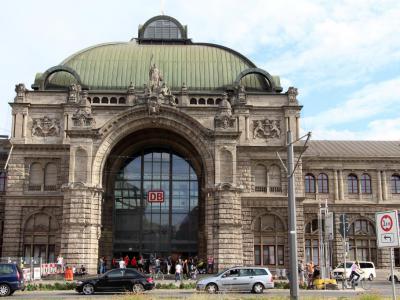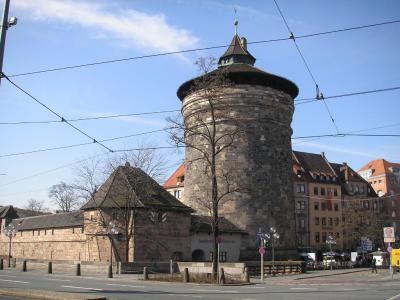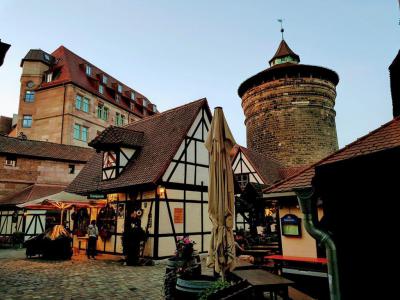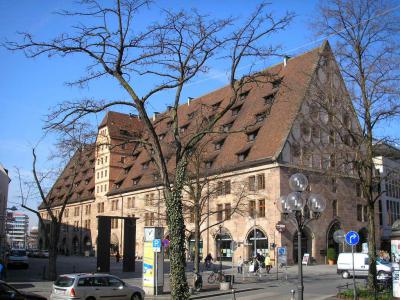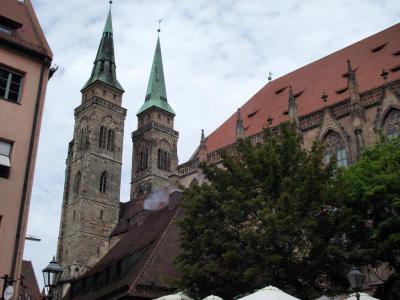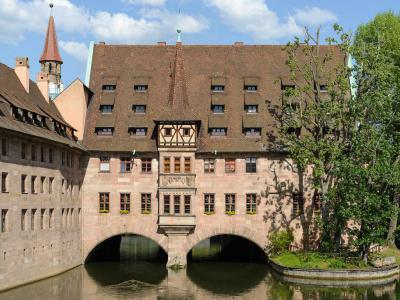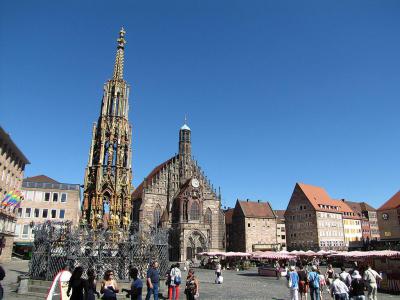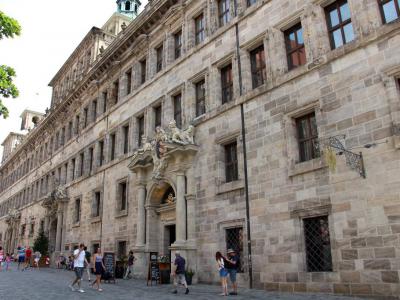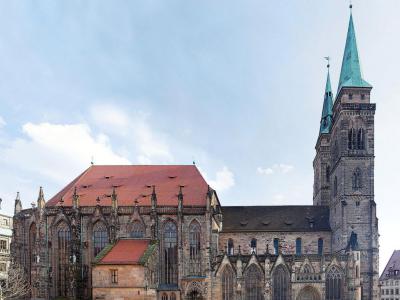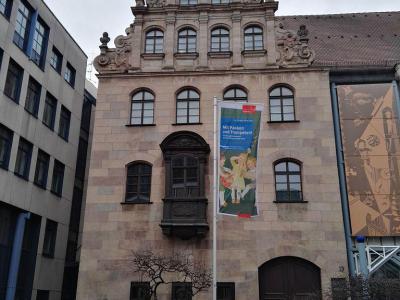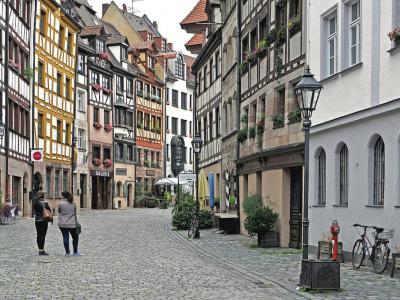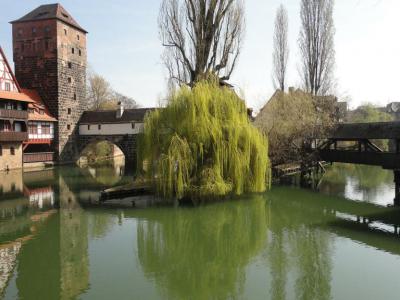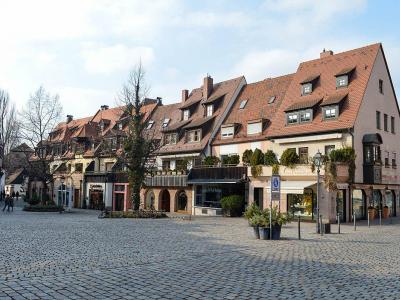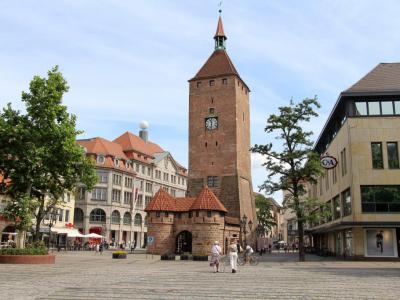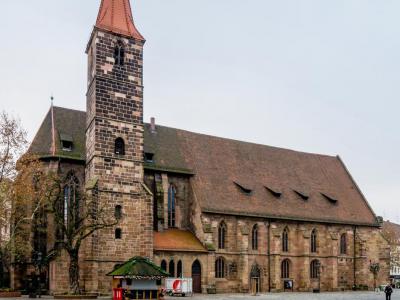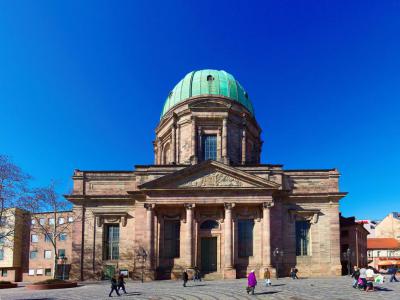
Nuremberg Old Town Walking Tour (Self Guided), Nuremberg
The historical center of Nuremberg, Old Town (German: Altstadt) is easily differentiated from other parts of the city. Divided in two by the Pegnitz River, the district represents a complex architectural ensemble with a maze of historical lanes (e.g. Weissgerbergasse) packed with half-timber houses, linked by centuries-old bridges, such as Maxbrücke, and set against the picturesque backdrops of large churches like St. Sebaldus' and St. Lawrence's, as well as medieval sites like the Heilig-Geist-Spital found along the banks.
Under the Nazi dictatorship, the Old City was cleansed of everything ideologically unsuitable, plus the Allied air raids nearly totally destroyed much of what was left by the end of World War II. Luckily, as early as in 1945, reconstruction began, and in 1950 a general plan was outlined, set to restore the Old Town structure. Today, this historical area is just as gorgeous as it once was, fit to make anyone walk around for hours, not getting enough of it.
If you arrive in Central Station – the imposing Neo-Baroque edifice, the birthplace of the German railway – you can start your journey near the Frauentorturm, one of the four main towers in Nuremberg's medieval fortification, and proceed in the direction of the Imperial Castle. Pretty much all the attractions along the way will be worthy of attention, be it the Mauthalle (Former Customs House) from the late 15th century; Hauptmarkt (Main Market Square) – center of local commerce since ancient times; or the Rathaus (City Hall) – one of the most important buildings in Nuremberg; to mention but a few.
The city's medieval center is best explored on foot. All you need, apart from GPSmyCity mobile app, to enjoy this self-guided walking tour are a pair of comfortable shoes, a backpack, and a camera.
Under the Nazi dictatorship, the Old City was cleansed of everything ideologically unsuitable, plus the Allied air raids nearly totally destroyed much of what was left by the end of World War II. Luckily, as early as in 1945, reconstruction began, and in 1950 a general plan was outlined, set to restore the Old Town structure. Today, this historical area is just as gorgeous as it once was, fit to make anyone walk around for hours, not getting enough of it.
If you arrive in Central Station – the imposing Neo-Baroque edifice, the birthplace of the German railway – you can start your journey near the Frauentorturm, one of the four main towers in Nuremberg's medieval fortification, and proceed in the direction of the Imperial Castle. Pretty much all the attractions along the way will be worthy of attention, be it the Mauthalle (Former Customs House) from the late 15th century; Hauptmarkt (Main Market Square) – center of local commerce since ancient times; or the Rathaus (City Hall) – one of the most important buildings in Nuremberg; to mention but a few.
The city's medieval center is best explored on foot. All you need, apart from GPSmyCity mobile app, to enjoy this self-guided walking tour are a pair of comfortable shoes, a backpack, and a camera.
How it works: Download the app "GPSmyCity: Walks in 1K+ Cities" from Apple App Store or Google Play Store to your mobile phone or tablet. The app turns your mobile device into a personal tour guide and its built-in GPS navigation functions guide you from one tour stop to next. The app works offline, so no data plan is needed when traveling abroad.
Nuremberg Old Town Walking Tour Map
Guide Name: Nuremberg Old Town Walking Tour
Guide Location: Germany » Nuremberg (See other walking tours in Nuremberg)
Guide Type: Self-guided Walking Tour (Sightseeing)
# of Attractions: 17
Tour Duration: 3 Hour(s)
Travel Distance: 3.8 Km or 2.4 Miles
Author: Ella
Sight(s) Featured in This Guide:
Guide Location: Germany » Nuremberg (See other walking tours in Nuremberg)
Guide Type: Self-guided Walking Tour (Sightseeing)
# of Attractions: 17
Tour Duration: 3 Hour(s)
Travel Distance: 3.8 Km or 2.4 Miles
Author: Ella
Sight(s) Featured in This Guide:
- Nuremberg Central Station
- Frauentorturm (Women's Gate Tower)
- Handwerkerhof (Crafts Yard)
- Mauthalle (Former Customs House)
- St. Lawrence's Church
- Heilig-Geist-Spital (Hospice of the Holy Spirit)
- Hauptmarkt (Main Market Square)
- City Hall (Rathaus)
- St. Sebaldus Church
- Nuremberg Toy Museum
- Weissgerbergasse (Weissgerber Street)
- Maxbrücke (Max Bridge)
- Trodelmarkt (Flea Market)
- Ludwigsplatz (Ludwig's Square)
- St. Jakobskirche (St. Jacob's Church)
- St. Elizabeth's Cathedral
- Zum Guldenen Stern Restaurant
1) Nuremberg Central Station
Nuremberg Central Station (German: Nürnberg Hauptbahnhof) is the largest station in north Bavaria and belongs to the 20 stations in the highest category of importance allocated by DB Station&Service. The Hauptbahnhof is located on the southeastern perimeter of Nuremberg's Altstadt, immediately opposite the Königstor (King's Gate) where the streets of Marientorgraben, Frauentorgraben, and Bahnhofstraße meet. The DB Museum, the corporate museum of Deutsche Bahn AG (formerly the Verkehrsmuseum), is close to the station, as is the Staatstheater Nürnberg opera house.
Having been originally built as in the neo-Gothic style, the station was rebuilt in 1900 largely in the Neo-Baroque style. The most striking feature is the muschelkalk which characterizes the exterior façade. The portals to the individual halls are richly decorated and primarily depict symbols of technological progress; for example, a winged wheel above the portal in the Mittelhalle. The lounge, in which the present-day travel center is located, was built in 1904/1905 by Bruno Paul in the Jugendstil. Sections of the walls are decorated with fine mosaics, the roof is ornamented with unobtrusive stucco.
The Jugendstil lounge is one of the few areas of the station, which has survived the destruction of the Second World War. Above the main portal is an advertising column from the early 20th century.
In 1950 plans were made to change the Neo-Baroque style to a Neo-Gothic style. Shortly before work began, however, it was stopped so that only a few areas were changed.
Why You Should Visit:
While the building itself is very nice it is worth noting that the reason Nuremberg was chosen for the Nazi rallying grounds was its ability to link Germany by rail, so this central station is historical as well.
Having been originally built as in the neo-Gothic style, the station was rebuilt in 1900 largely in the Neo-Baroque style. The most striking feature is the muschelkalk which characterizes the exterior façade. The portals to the individual halls are richly decorated and primarily depict symbols of technological progress; for example, a winged wheel above the portal in the Mittelhalle. The lounge, in which the present-day travel center is located, was built in 1904/1905 by Bruno Paul in the Jugendstil. Sections of the walls are decorated with fine mosaics, the roof is ornamented with unobtrusive stucco.
The Jugendstil lounge is one of the few areas of the station, which has survived the destruction of the Second World War. Above the main portal is an advertising column from the early 20th century.
In 1950 plans were made to change the Neo-Baroque style to a Neo-Gothic style. Shortly before work began, however, it was stopped so that only a few areas were changed.
Why You Should Visit:
While the building itself is very nice it is worth noting that the reason Nuremberg was chosen for the Nazi rallying grounds was its ability to link Germany by rail, so this central station is historical as well.
Sight description based on Wikipedia.
2) Frauentorturm (Women's Gate Tower)
Once known as "Blau Q", the Frauentorturm is one of the four main towers in Nuremberg's Old Town fortification – located southeastern part of it, guarding the Frauentor (Women's Gate). The latter was named so after the Klarakloster (The Poor Clare Convent of St. Klara) situated behind it.
Considering the earliest payment documents for the gate keeper dated 1386, it is safe to assume that the gate's construction was completed by this year at latest. The structure replaced the inner Frauentor of the penultimate city wall, demolished in 1498, when The Mauthalle (Customs House) was built. In 1558, the tower was remodeled to its current round appearance, with a side gate built in.
After the Königstor was completed in 1849, the Frauentor served outgoing traffic. Today the gate is reserved solely for pedestrian use and has the Nuremberg Crafts Yard set up in its armory.
Given its location – opposite the Central Railway Station, the Frauentorturm is one of the first things you can see upon arrival in Nuremberg by train.
Considering the earliest payment documents for the gate keeper dated 1386, it is safe to assume that the gate's construction was completed by this year at latest. The structure replaced the inner Frauentor of the penultimate city wall, demolished in 1498, when The Mauthalle (Customs House) was built. In 1558, the tower was remodeled to its current round appearance, with a side gate built in.
After the Königstor was completed in 1849, the Frauentor served outgoing traffic. Today the gate is reserved solely for pedestrian use and has the Nuremberg Crafts Yard set up in its armory.
Given its location – opposite the Central Railway Station, the Frauentorturm is one of the first things you can see upon arrival in Nuremberg by train.
Sight description based on Wikipedia.
3) Handwerkerhof (Crafts Yard)
The Crafts Yard opened in 1971 and features traditional crafts. Visitors and locals can watch craft creators at work using traditional tools to create handmade goods. The Crafts Yard invited visitors to go back to a time period when goods were painstakingly made by hand and were treasured possessions, often passed from generation to generation.
The Crafts Yard is located in the Free Imperial City's former armory. Surrounded by the ancient town wall, the Crafts Yard features narrow walkways, half-timbered houses, and cozy inns.
As you stroll through the yard, you can walk tinsmiths and woodworkers making toys and goldsmiths creating art. Crafters create traditional goods such as model railways, miniature doll prams, and handmade figurines.
The yard hosts exhibitions showcasing crafting traditions such as bookbinding and gingerbread making.
Visitors can watch the artists at work as well as purchase these unique items. Bring home beautifully handmade souvenirs and gifts.
The Crafts Yard also has delightful cafes, restaurants, and bars sprinkled about the craft shops.
The Crafts Yard is located in the Free Imperial City's former armory. Surrounded by the ancient town wall, the Crafts Yard features narrow walkways, half-timbered houses, and cozy inns.
As you stroll through the yard, you can walk tinsmiths and woodworkers making toys and goldsmiths creating art. Crafters create traditional goods such as model railways, miniature doll prams, and handmade figurines.
The yard hosts exhibitions showcasing crafting traditions such as bookbinding and gingerbread making.
Visitors can watch the artists at work as well as purchase these unique items. Bring home beautifully handmade souvenirs and gifts.
The Crafts Yard also has delightful cafes, restaurants, and bars sprinkled about the craft shops.
4) Mauthalle (Former Customs House)
This medieval building has served as a granary and customhouse throughout its centuries-old history. It was built as a granary around 1498 on the site of the former city moat. At the time, this was the largest grain house in the city and stored food for times of crisis.
The Former Customs House features a gabled roof. The eastern gable has an intricate network of blind ogee arches. The city's coat of arms, with the imperial eagle, is featured in the lancet-arched portal.
The impressive roof has five stories and rests on top of the three-story sandstone building.
The granary began serving as a customhouse in 1572. The building was heavily damaged during WWII but has been restored. The original builders used half-timbers on the facade; the remaining half-timbered facade can be seen on the building's easter wing. The rest of the building was rebuilt using brick.
The cellar features 26 pillars and now houses the Barefoot brewery and restaurant.
The Former Customs House features a gabled roof. The eastern gable has an intricate network of blind ogee arches. The city's coat of arms, with the imperial eagle, is featured in the lancet-arched portal.
The impressive roof has five stories and rests on top of the three-story sandstone building.
The granary began serving as a customhouse in 1572. The building was heavily damaged during WWII but has been restored. The original builders used half-timbers on the facade; the remaining half-timbered facade can be seen on the building's easter wing. The rest of the building was rebuilt using brick.
The cellar features 26 pillars and now houses the Barefoot brewery and restaurant.
5) St. Lawrence's Church (must see)
Dedicated to one of the most venerated saints of the Roman Catholic Church, this church was badly damaged during World War II and later restored, now standing as one of the most prominent among the Evangelical Lutheran churches in Bavaria. More notably, the church is rich in 14th and 15th Century altarpieces, the earliest dating from 1316.
The church’s Gothic choir called "St. Laurentius" was designed by medieval master mason Konrad Roriczer in 1445. There are also notable sculptures, including the famous statue of the "beautiful Madonna" – unusually portrayed smiling – from around 1280. Most striking is a stunning stone tabernacle, (built in 1493-6) the carvings of which depict the Passion of Christ. It is surmounted by a veritable explosion of pinnacles which soar 20 meters to the springing of the vaulting. As if this were not enough, the church has an exceptional array of medieval stained glass, mostly from the 15th century.
The building and furnishing of the church were cared of by the city council and by wealthy citizens. This is probably the reason why the art treasures of St. Lawrence were spared during the iconoclasm during the Reformation period. Despite St. Lawrence's being one of the first churches in Germany to be Lutheran (1525), the wealthy citizens of Nuremberg wanted to preserve the memory of their ancestors and refused the removal of the donated works of art.
The west facade is richly articulated, reflecting the wealth of the Nuremberg citizens. The facade is dominated by the two towers, mirroring St. Sebald and indirectly Bamberg Cathedral with a sharp towering West portal doorway, and an indented rose window 9 meters in diameter.
The church’s Gothic choir called "St. Laurentius" was designed by medieval master mason Konrad Roriczer in 1445. There are also notable sculptures, including the famous statue of the "beautiful Madonna" – unusually portrayed smiling – from around 1280. Most striking is a stunning stone tabernacle, (built in 1493-6) the carvings of which depict the Passion of Christ. It is surmounted by a veritable explosion of pinnacles which soar 20 meters to the springing of the vaulting. As if this were not enough, the church has an exceptional array of medieval stained glass, mostly from the 15th century.
The building and furnishing of the church were cared of by the city council and by wealthy citizens. This is probably the reason why the art treasures of St. Lawrence were spared during the iconoclasm during the Reformation period. Despite St. Lawrence's being one of the first churches in Germany to be Lutheran (1525), the wealthy citizens of Nuremberg wanted to preserve the memory of their ancestors and refused the removal of the donated works of art.
The west facade is richly articulated, reflecting the wealth of the Nuremberg citizens. The facade is dominated by the two towers, mirroring St. Sebald and indirectly Bamberg Cathedral with a sharp towering West portal doorway, and an indented rose window 9 meters in diameter.
Sight description based on Wikipedia.
6) Heilig-Geist-Spital (Hospice of the Holy Spirit)
The Hospice of the Holy Spirit was completed in 1339. The Imperial Mayor built it to provide care to the poor and needy in the area. At the time, it was the largest hospital in the Empire.
The hospital was expanded in the 16th century and stretched over the Pegntiz River. Today, visitors can view the "Sude," which housed the preacher, and the northern wall of the Hospice Church. The church has a polygonal roof turret.
An additional chapel that fell into ruins housed the crown jewels of the Empire from 1424 to 1796. These crown jewels included royal regalia and the Holy Lance, which was shown to believers once a year. In addition, the royal regalia would be transported to Frankfurt Cathedral for coronations.
The hospital houses Nuremberg's oldest bronze sculpture, which was created around 1380. Adam Kraft's Calvary dates to the early 1500s and is located in the Crucifixion Courtyard.
Today, the Hospice of the Holy Spirit houses a senior home as well as a restaurant. The medieval architecture reflecting over the river makes for an impressive photo opportunity.
The hospital was expanded in the 16th century and stretched over the Pegntiz River. Today, visitors can view the "Sude," which housed the preacher, and the northern wall of the Hospice Church. The church has a polygonal roof turret.
An additional chapel that fell into ruins housed the crown jewels of the Empire from 1424 to 1796. These crown jewels included royal regalia and the Holy Lance, which was shown to believers once a year. In addition, the royal regalia would be transported to Frankfurt Cathedral for coronations.
The hospital houses Nuremberg's oldest bronze sculpture, which was created around 1380. Adam Kraft's Calvary dates to the early 1500s and is located in the Crucifixion Courtyard.
Today, the Hospice of the Holy Spirit houses a senior home as well as a restaurant. The medieval architecture reflecting over the river makes for an impressive photo opportunity.
7) Hauptmarkt (Main Market Square) (must see)
The Main Market Square has been the center of activity and commerce in Nuremberg since ancient times. The celebrated marketplace runs Monday through Saturday. Visitors and locals love to shop the plentiful fruits and vegetables, fresh bread, treats, ready-to-eat meals, and fresh flowers.
The Main Market Square features several iconic landmarks. The Beautiful Fountain was completed in 1396 and is a Gothic masterpiece. It stands an impressive 19 meters (62 feet) tall.
Forty ornate figures decorate the fountain. The figures represent important icons in the Holy Roman Empire such as philosophy, liberal arts, the four Church Fathers, the four Evangelists, the seven Prince-electors, the Nine Worthies, Moses, and the seven Prophets. Legend tells of good luck brought to visitors who spin the two brass rings on the fence.
Another impressive landmark on the square is The Church of Our Lady. This Gothic church was built in the 14th century and features a beautiful facade.
The Main Market Square hosts various festivals and events throughout the year. Popular events include the Nuremberg Flea Market, the Nuremberg Old Town Festival, and the Christmas market.
The Main Market Square features several iconic landmarks. The Beautiful Fountain was completed in 1396 and is a Gothic masterpiece. It stands an impressive 19 meters (62 feet) tall.
Forty ornate figures decorate the fountain. The figures represent important icons in the Holy Roman Empire such as philosophy, liberal arts, the four Church Fathers, the four Evangelists, the seven Prince-electors, the Nine Worthies, Moses, and the seven Prophets. Legend tells of good luck brought to visitors who spin the two brass rings on the fence.
Another impressive landmark on the square is The Church of Our Lady. This Gothic church was built in the 14th century and features a beautiful facade.
The Main Market Square hosts various festivals and events throughout the year. Popular events include the Nuremberg Flea Market, the Nuremberg Old Town Festival, and the Christmas market.
8) City Hall (Rathaus)
The City Hall is one of the most important buildings in Nuremberg. Construction of this imposing building began in 1332. The oldest part of the complex is the great ceremonial hall, a stunning example of Gothic architecture. When it was completed in 1340, the ceremonial hall was the largest in the area.
The city hall was expanded in the early 17th century. Architect Jakob Wolff designed a palazzo-like building that is reminiscent of the Italian Renaissance. The facade features three Baroque portals, and the central portal contains the city's two coats of arms and the imperial eagle.
In 1649, the city celebrated the end of the Thirty Year's War with a massive Peace Banquet in the city hall.
Replicas of medieval imperial regalia are on display on the first floor. In the cellar, visitors will find medieval dungeons.
Bombs destroyed city Hall during WWII. However, it was painstakingly reconstructed and reopened in 1962.
The city hall was expanded in the early 17th century. Architect Jakob Wolff designed a palazzo-like building that is reminiscent of the Italian Renaissance. The facade features three Baroque portals, and the central portal contains the city's two coats of arms and the imperial eagle.
In 1649, the city celebrated the end of the Thirty Year's War with a massive Peace Banquet in the city hall.
Replicas of medieval imperial regalia are on display on the first floor. In the cellar, visitors will find medieval dungeons.
Bombs destroyed city Hall during WWII. However, it was painstakingly reconstructed and reopened in 1962.
9) St. Sebaldus Church
Located at the Albrecht-Dürer-Platz, in front of the old city hall, the St. Sebaldus Church takes its name from Sebaldus, an 8th-century hermit and missionary and patron saint of Nuremberg. It was originally built as a Romanesque basilica with two choirs in the 1230s with the two towers having been added in the 15th century. In the middle 17th century, galleries were also added and the interior was remodeled in Baroque fashion.
The church suffered serious damage during World War II and was subsequently reconstructed. Some of the old interior did survive, including the Shrine of St. Sebaldus, works by Veit Stoss and the stained glass windows. The church had an organ by the 14th century, and another by the 15th.
The main organ had been built in 1440–41 by Heinrich Traxdorf, who also built two small organs for Nuremberg's Frauenkirche. Until its destruction in the 20th century it was one of the oldest playable organs in the world, and all the more notable because Traxdorf was one of the first organ builders to depart from the Gothic Blockwerk organ by dividing the windchests and separating the front stops into Flute (Principal) and Octave (see pipe organ).
Why You Should Visit:
Great atmosphere that puts you back into medieval times! Also in a beautiful area, just off the northwest corner of the Main Market.
Tip:
Admission is free at the public church tours, although donations are appreciated. For tower tours, the fee is €5 (children €2).
Several times a year, the church and tower are open until late at night, as part of the "Blue Night" festivities in Nuremberg.
The church suffered serious damage during World War II and was subsequently reconstructed. Some of the old interior did survive, including the Shrine of St. Sebaldus, works by Veit Stoss and the stained glass windows. The church had an organ by the 14th century, and another by the 15th.
The main organ had been built in 1440–41 by Heinrich Traxdorf, who also built two small organs for Nuremberg's Frauenkirche. Until its destruction in the 20th century it was one of the oldest playable organs in the world, and all the more notable because Traxdorf was one of the first organ builders to depart from the Gothic Blockwerk organ by dividing the windchests and separating the front stops into Flute (Principal) and Octave (see pipe organ).
Why You Should Visit:
Great atmosphere that puts you back into medieval times! Also in a beautiful area, just off the northwest corner of the Main Market.
Tip:
Admission is free at the public church tours, although donations are appreciated. For tower tours, the fee is €5 (children €2).
Several times a year, the church and tower are open until late at night, as part of the "Blue Night" festivities in Nuremberg.
Sight description based on Wikipedia.
10) Nuremberg Toy Museum (must see)
Nuremberg has been building beloved toys for over 600 years. Its artists have created dolls, pewter figurines, and modern toys.
Lydia Bayer began collecting toys in the 1920s. After Lydia's death, her daughter opened the Lydia Bayer Museum and displayed the impressive collection. The Bayer heirs later collaborated with the city to open the Toy Museum.
Today, the Toy Museum features over 80,000 items and houses several exhibits.
The Lydia Bayer "Cabinet" commemorates Lydia Bayer and her daughter, who were vital to the museum's collection and success. The room features some of Bayers' finest pieces.
In the Dolls, Parlors, Kitchens exhibit, visitors can see four centuries of dolls, mini-kitchens, market stalls, and shops. Girls were historically encouraged to play in these kitchens and shopping replicas to prepare them for life as housewives.
In this exhibit, visitors can discover how dolls have evolved through the centuries.
The Technology and Work exhibit shows off toys that reflect technical achievements. As new inventions and technologies were introduced, toys quickly followed. Children and adults alike wanted miniature versions of the steam engine, railroad, telephone, automobile, and airplane. These technology toys were made of iron and often featured clockwork mechanisms. This area features metal toys made in America. Visitors will be impressed by the model cars, trains, and model railways.
In the Toys Since 1945 section, visitors can see modern toys such as Matchbox cars and Barbie dolls.
On the top floor, visitors will find a wonderful play area for kids. In addition, there's a builder's shed, and artistic handicrafts are available. Finally, there's an outdoor play area where kids can play classic games.
Lydia Bayer began collecting toys in the 1920s. After Lydia's death, her daughter opened the Lydia Bayer Museum and displayed the impressive collection. The Bayer heirs later collaborated with the city to open the Toy Museum.
Today, the Toy Museum features over 80,000 items and houses several exhibits.
The Lydia Bayer "Cabinet" commemorates Lydia Bayer and her daughter, who were vital to the museum's collection and success. The room features some of Bayers' finest pieces.
In the Dolls, Parlors, Kitchens exhibit, visitors can see four centuries of dolls, mini-kitchens, market stalls, and shops. Girls were historically encouraged to play in these kitchens and shopping replicas to prepare them for life as housewives.
In this exhibit, visitors can discover how dolls have evolved through the centuries.
The Technology and Work exhibit shows off toys that reflect technical achievements. As new inventions and technologies were introduced, toys quickly followed. Children and adults alike wanted miniature versions of the steam engine, railroad, telephone, automobile, and airplane. These technology toys were made of iron and often featured clockwork mechanisms. This area features metal toys made in America. Visitors will be impressed by the model cars, trains, and model railways.
In the Toys Since 1945 section, visitors can see modern toys such as Matchbox cars and Barbie dolls.
On the top floor, visitors will find a wonderful play area for kids. In addition, there's a builder's shed, and artistic handicrafts are available. Finally, there's an outdoor play area where kids can play classic games.
11) Weissgerbergasse (Weissgerber Street)
Weissgerber Street is one of the most beautiful streets in Nuremberg. While much of Nuremberg was damaged during WWII, this street features over a dozen historical homes that survived intact. The historical homes feature traditional half-timber construction and show off Nuremberg's delightful architecture.
Weissgerber refers to the tanners who lived in this lane. These tanners used potassium aluminum sulfate to craft soft, fine leather. First, the hides were soaked and treated with a rammer. Next, the tallow was scraped off with a special blade, and then tanners dried the leather in frames on the city wall. A depiction of a rammer and knife is visible at Number 24.
Today, the street is no longer home to leatherworks, but it is a popular spot for galleries, restaurants, and bars.
The beautifully preserved half-timbered buildings with colorful latticework make Weissgerber Street one of the most photographed spots in Nuremberg.
Weissgerber refers to the tanners who lived in this lane. These tanners used potassium aluminum sulfate to craft soft, fine leather. First, the hides were soaked and treated with a rammer. Next, the tallow was scraped off with a special blade, and then tanners dried the leather in frames on the city wall. A depiction of a rammer and knife is visible at Number 24.
Today, the street is no longer home to leatherworks, but it is a popular spot for galleries, restaurants, and bars.
The beautifully preserved half-timbered buildings with colorful latticework make Weissgerber Street one of the most photographed spots in Nuremberg.
12) Maxbrücke (Max Bridge)
The Maxbrücke is an arch bridge over the Pegnitz in the old town of Nuremberg . The three-bay sandstone cuboid bridge has tracery fillings made of cast iron and is considered the oldest stone bridge in the city. It connects the Unschlittplatz in the Lorenz old town south of the Pegnitz with the Nägeleinsplatz in the north of the Sebald old town. The structure is located between the flea market island in the east and the Kettensteg in the west.
The Max Bridge was built by the Rothenburg master builder Jakob Grimm and was completed in 1457. At that time it was called the Stone Bridge . Later, in order to be able to defend the city against attacks from the river, two round cannons were added. In honor of the Bavarian King Maximilian I Joseph , the bridge was renamed Maxbrücke in 1810 . The place on the new building near the north side of the bridge was given its current name Maxplatz for the same reason .
The Maxbrücke was damaged by a fire in the wooden water tower of the Nägeleinsmühle on the northern bank of the Pegnitz, so that it was repaired and redesigned according to plans by Bernhard Solger . In 1852 it was opened to traffic again.
The bridge offers sweeping views to the Weinstadel and Henkerssteg.
The Weinstadel is a medieval and imperial city building in Nuremberg . It is one of the most famous architectural monuments in the northern part of Nuremberg's old town and is a stop on the Nuremberg Historical Mile . The name Weinstadel is derived from its function as a former imperial city wine warehouse, which was set up around 1571 on the ground floor of the main building.
Henkerssteg (Hangman's Bridge) is a wooden bridge built in 1457 for the town’s hangman who lived in a tower outside of the community. After a flood in 1595, the bridge was reconstructed and a tiled roof was added.
The Max Bridge was built by the Rothenburg master builder Jakob Grimm and was completed in 1457. At that time it was called the Stone Bridge . Later, in order to be able to defend the city against attacks from the river, two round cannons were added. In honor of the Bavarian King Maximilian I Joseph , the bridge was renamed Maxbrücke in 1810 . The place on the new building near the north side of the bridge was given its current name Maxplatz for the same reason .
The Maxbrücke was damaged by a fire in the wooden water tower of the Nägeleinsmühle on the northern bank of the Pegnitz, so that it was repaired and redesigned according to plans by Bernhard Solger . In 1852 it was opened to traffic again.
The bridge offers sweeping views to the Weinstadel and Henkerssteg.
The Weinstadel is a medieval and imperial city building in Nuremberg . It is one of the most famous architectural monuments in the northern part of Nuremberg's old town and is a stop on the Nuremberg Historical Mile . The name Weinstadel is derived from its function as a former imperial city wine warehouse, which was set up around 1571 on the ground floor of the main building.
Henkerssteg (Hangman's Bridge) is a wooden bridge built in 1457 for the town’s hangman who lived in a tower outside of the community. After a flood in 1595, the bridge was reconstructed and a tiled roof was added.
Sight description based on Wikipedia.
13) Trodelmarkt (Flea Market)
Trodelmarkt is an island named after the flea market held here. It is located in the west of the old town between Maxbrücke and Fleischbrücke . The island is connected to the mainland via the Charles Bridge as well as the Henkersteg in the southwest and the Schleifersteg in the northeast. In the northwest there is a bridge belonging to the executioner's tower , in which a legal history exhibition on the life and work of the executioner is shown.
When the two previously separate city fortifications on the Lorenzer and Sebalder sides of the old town were combined across the Pegnitz between 1320 and 1325, the so-called executioner's tower was built as part of the fortifications on the western tip of the island.
A market was held on the island as early as the Middle Ages. At that time pigs were traded there, which is why the square was called Säumarkt . In 1444, a meat house, the so-called Small Meat Bank, was built on the island in addition to the already existing meat banks on the southwest side of the main market . The newly built meat shop included 19 new meat banks and 32 meat banks for butchers who did not come from Nuremberg.
Grinding mills have been in operation on the island and in its vicinity since 1440 .
From the 16th century, the citizens of the Sebald (northern) side of the old town on the island began trading old and used items. That is why the Säumarkt was renamed the flea market in 1809/1810 . The meat store had to give way to a market hall, which was built there in 1895-1897.
The characteristic development - narrow rows of houses with sales stalls in front of them - was completely destroyed in bombing raids during World War II. During the reconstruction after the war, attempts were made to recreate the old structures.
Trodelmarkt hosts a great 1,000 square meter flea market twice a year. It lasts 3 days in May and September. A variety of goods can be bought from its many vendors, including toys, jewelry and much more.
When the two previously separate city fortifications on the Lorenzer and Sebalder sides of the old town were combined across the Pegnitz between 1320 and 1325, the so-called executioner's tower was built as part of the fortifications on the western tip of the island.
A market was held on the island as early as the Middle Ages. At that time pigs were traded there, which is why the square was called Säumarkt . In 1444, a meat house, the so-called Small Meat Bank, was built on the island in addition to the already existing meat banks on the southwest side of the main market . The newly built meat shop included 19 new meat banks and 32 meat banks for butchers who did not come from Nuremberg.
Grinding mills have been in operation on the island and in its vicinity since 1440 .
From the 16th century, the citizens of the Sebald (northern) side of the old town on the island began trading old and used items. That is why the Säumarkt was renamed the flea market in 1809/1810 . The meat store had to give way to a market hall, which was built there in 1895-1897.
The characteristic development - narrow rows of houses with sales stalls in front of them - was completely destroyed in bombing raids during World War II. During the reconstruction after the war, attempts were made to recreate the old structures.
Trodelmarkt hosts a great 1,000 square meter flea market twice a year. It lasts 3 days in May and September. A variety of goods can be bought from its many vendors, including toys, jewelry and much more.
14) Ludwigsplatz (Ludwig's Square)
Nuremberg’s Ludwigsplatz (Ludwig's Square) has been particularly famous since 1984, as the site of an unusual fountain.
Another local attraction close-by, somewhat older, the White Tower, appeared in 1250 as part of the medieval fortification complex. Its white color was hard to maintain, and so to keep it clean, the grumpiest of city wives were employed regularly, as part of their reformation process. At some point, either the wives became too complaisant or the husbands resigned themselves, but the tower plaster turned completely non-white and had to be removed – during restoration after World War II; but the name stuck.
In 1972, the White Tower began to serve as an entrance to the newly-built subway station. During the construction, a ventilation shaft was erected in front of it, which by no means adorned the area. In a bid to conceal it, the city authorities announced a competition for the best idea. The winner was Professor Jürgen Werber, a sculptor by profession, who proposed to create a composition based on the poem "Bittersweet Family Life" by the famous German poet, Hans Sachs, who lived in Nuremberg in the Middle Ages.
Called the Brunnen (Marriage) Carousel, the fountain reflects different stages of married life, its joyful and sad moments, depicted in bronze. The six sculptural groups are arranged in a circle on stylized carriages in the form of different animals, and represent stages of relationship between husbands and wives – from the first passion to death. Each composition has a hint and a hidden meaning that everyone is free to interpret their own way.
The fountain is a true work of art and causes a great deal of controversy to this day. There are always lots of tourists hurrying to snap a shot of the fountain or themselves in front of it.
Another local attraction close-by, somewhat older, the White Tower, appeared in 1250 as part of the medieval fortification complex. Its white color was hard to maintain, and so to keep it clean, the grumpiest of city wives were employed regularly, as part of their reformation process. At some point, either the wives became too complaisant or the husbands resigned themselves, but the tower plaster turned completely non-white and had to be removed – during restoration after World War II; but the name stuck.
In 1972, the White Tower began to serve as an entrance to the newly-built subway station. During the construction, a ventilation shaft was erected in front of it, which by no means adorned the area. In a bid to conceal it, the city authorities announced a competition for the best idea. The winner was Professor Jürgen Werber, a sculptor by profession, who proposed to create a composition based on the poem "Bittersweet Family Life" by the famous German poet, Hans Sachs, who lived in Nuremberg in the Middle Ages.
Called the Brunnen (Marriage) Carousel, the fountain reflects different stages of married life, its joyful and sad moments, depicted in bronze. The six sculptural groups are arranged in a circle on stylized carriages in the form of different animals, and represent stages of relationship between husbands and wives – from the first passion to death. Each composition has a hint and a hidden meaning that everyone is free to interpret their own way.
The fountain is a true work of art and causes a great deal of controversy to this day. There are always lots of tourists hurrying to snap a shot of the fountain or themselves in front of it.
Sight description based on Wikipedia.
15) St. Jakobskirche (St. Jacob's Church)
St. Jakobskirche is a medieval church in Nuremberg, dedicated to Saint Jakob, otherwise known as Saint James the Greater.
The original church on this site was founded on 20 February 1209 by Otto IV, Holy Roman Emperor. The small Romanesque chapel was demolished some 80 years later and a new church was built in its place. That church soon came into the possession of the Knights of St John. Under Frederick II, the knightly order enjoyed great prosperity and received many new properties.
During the Reformation, the Church of St. James became Protestant. In 1531, it came into the possession of the Catholic Teutonic Order.
In 1632, during the Thirty Years' War, King Gustav Adolf expropriated the church and handed it over to the city of Nuremberg, upon which it underwent an extensive renovation. Under the provisions of the Treaty of Westphalia, the church once again returned to the Teutonic Order – in 1648. The Order kept its hold until 1809, when Napoleon Bonaparte ordered its dissolution and the Order lost its last secular holdings.
In 1810, St. Jakob's became the third Protestant parish church in the city. At some point, this Gothic-style edifice served as a hospice for the elderly and was badly damaged during World War II, but then restored.
Among other notable things, the temple contains the beautifully decorated late Gothic Twelve Messenger Altar with reredos dating back to 1360–1370, the Mourning of Christ sculpture by an unknown artist from the 16th century, and a three manual pipe organ by Steinmeyer Orgelbau dating from 1968.
The original church on this site was founded on 20 February 1209 by Otto IV, Holy Roman Emperor. The small Romanesque chapel was demolished some 80 years later and a new church was built in its place. That church soon came into the possession of the Knights of St John. Under Frederick II, the knightly order enjoyed great prosperity and received many new properties.
During the Reformation, the Church of St. James became Protestant. In 1531, it came into the possession of the Catholic Teutonic Order.
In 1632, during the Thirty Years' War, King Gustav Adolf expropriated the church and handed it over to the city of Nuremberg, upon which it underwent an extensive renovation. Under the provisions of the Treaty of Westphalia, the church once again returned to the Teutonic Order – in 1648. The Order kept its hold until 1809, when Napoleon Bonaparte ordered its dissolution and the Order lost its last secular holdings.
In 1810, St. Jakob's became the third Protestant parish church in the city. At some point, this Gothic-style edifice served as a hospice for the elderly and was badly damaged during World War II, but then restored.
Among other notable things, the temple contains the beautifully decorated late Gothic Twelve Messenger Altar with reredos dating back to 1360–1370, the Mourning of Christ sculpture by an unknown artist from the 16th century, and a three manual pipe organ by Steinmeyer Orgelbau dating from 1968.
Sight description based on Wikipedia.
16) St. Elizabeth's Cathedral
St. Elizabeth's is a Roman Catholic church in Nuremberg, dedicated to Elizabeth of Hungary (also known as Saint Elizabeth of Thuringia) since 1235.
After the Reformation, this was the only Roman Catholic church left in the otherwise Protestant city. The building soon proved inadequate for its congregation, and the church entered into protracted negotiations with the city magistrate, which lasted from 1718 to 1780. Finally, an agreement was reached for a new church to be built, and so the old one was demolished in 1784.
Franz Ignaz Michael Neumann drew up plans for the Neoclassical-styled building with a large dome; the foundation stone for it was laid on 19 May 1785. Neumann died on 29 September 1789, and the project was taken over by Peter Anton von Verschaffelt. However, a large overrun in costs led to his resignation in 1789. Eventually topping off was completed in 1802 and in 1803 the dome was crowned with a golden cross.
In 1806 the church was secularized. On 27 January 1885, the Roman Catholic Archdiocese of Bamberg purchased the building, with further work being done to complete the design – by 1903. The building suffered severe damage during World War II, and was reconstructed between 1947 and 1959. Further restoration of the exterior was carried out from 1975 to 1976.
After the Reformation, this was the only Roman Catholic church left in the otherwise Protestant city. The building soon proved inadequate for its congregation, and the church entered into protracted negotiations with the city magistrate, which lasted from 1718 to 1780. Finally, an agreement was reached for a new church to be built, and so the old one was demolished in 1784.
Franz Ignaz Michael Neumann drew up plans for the Neoclassical-styled building with a large dome; the foundation stone for it was laid on 19 May 1785. Neumann died on 29 September 1789, and the project was taken over by Peter Anton von Verschaffelt. However, a large overrun in costs led to his resignation in 1789. Eventually topping off was completed in 1802 and in 1803 the dome was crowned with a golden cross.
In 1806 the church was secularized. On 27 January 1885, the Roman Catholic Archdiocese of Bamberg purchased the building, with further work being done to complete the design – by 1903. The building suffered severe damage during World War II, and was reconstructed between 1947 and 1959. Further restoration of the exterior was carried out from 1975 to 1976.
Sight description based on Wikipedia.
17) Zum Guldenen Stern Restaurant
This historic restaurant was originally built in 1380 on the cobbled Zirkelschmiedsgasse street. The restaurant was first mentioned in 1419 and has been serving bratwurst and other delectable dishes ever since. This is Nuremberg's oldest restaurant that has been continuously operating from the same location.
The restaurant features beautiful traditional architecture. The interior has low, wood panel ceilings, family-style seating, and a cozy fireplace.
The house specialty is the Nuremberg bratwurst. Local Nuremberg butchers produce the bratwurst. They are spiced using ancient recipes and are grilled fresh rather than pre-cooked. The bratwurst is roasted every day on an open beechwood fire.
Other menu items are also traditionally created. The Wehr family makes the barrel sauerkraut, and the homemade potato salad uses local potatoes. Don't miss the delicious apple strudel for dessert.
The restaurant features beautiful traditional architecture. The interior has low, wood panel ceilings, family-style seating, and a cozy fireplace.
The house specialty is the Nuremberg bratwurst. Local Nuremberg butchers produce the bratwurst. They are spiced using ancient recipes and are grilled fresh rather than pre-cooked. The bratwurst is roasted every day on an open beechwood fire.
Other menu items are also traditionally created. The Wehr family makes the barrel sauerkraut, and the homemade potato salad uses local potatoes. Don't miss the delicious apple strudel for dessert.
Walking Tours in Nuremberg, Germany
Create Your Own Walk in Nuremberg
Creating your own self-guided walk in Nuremberg is easy and fun. Choose the city attractions that you want to see and a walk route map will be created just for you. You can even set your hotel as the start point of the walk.
Hitler's Nuremberg Tour
Despite Nuremberg's storybook appearance, the city's not so distant past is rather dark. Back in 1933, amid the rise of the Third Reich, the Nazis worked really hard to leave their stamp on the city, prettifying it and renovating the architecture in a bid to accommodate their massive rallies and bombastic military parades.
In fact, no other city in Germany is more intertwined with the... view more
Tour Duration: 2 Hour(s)
Travel Distance: 4.9 Km or 3 Miles
In fact, no other city in Germany is more intertwined with the... view more
Tour Duration: 2 Hour(s)
Travel Distance: 4.9 Km or 3 Miles
Nuremberg Introduction Walking Tour
The most "German" of all cities in Germany, Nuremberg has witnessed many historic events in its lifetime. Sadly, the first thing immediately associated with Nuremberg is the rise of the Third Reich, the Nazi rallies, and the postwar trials over the Nazi leaders. Indeed, the city was favored by Hitler, who planned to build here a grandiose architectural complex for his party.
... view more
Tour Duration: 2 Hour(s)
Travel Distance: 2.8 Km or 1.7 Miles
... view more
Tour Duration: 2 Hour(s)
Travel Distance: 2.8 Km or 1.7 Miles
The Most Popular Cities
/ view all
